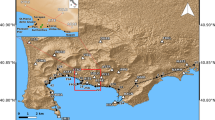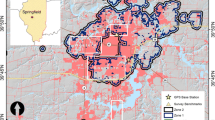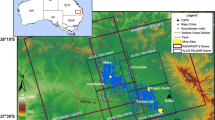Abstract
This paper presents application of satellite interferometric methods (persistent scatterer interferometric synthetic aperture radar (PSInSAR™) and differential interferometric synthetic aperture radar (DInSAR)) for observation of ground deformation in the Upper Silesian Coal Basin (USCB) in Southern Poland. The presented results were obtained during the DORIS project (EC FP 7, Grant Agreement n. 242212, www.doris-project.eu). Several InSAR datasets for this area were analysed. Most of them were processed by Tele-Rilevamento Europa - T.R.E. s.r.l. Italy. Datasets came from different SAR satellites (ERS 1 and 2, Envisat, ALOS- PALSAR and TerraSAR-X) and cover three different SAR bands (L, C and X). They were processed using both InSAR techniques: DInSAR, where deformations are presented as interferometric fringes on the raster image, and PSInSAR, where motion is indentified on irregular set of persistent scatterer (PS) points. Archival data from the C-band European Space Agency satellites ERS and ENVISAT provided information about ground movement since 1992 until 2010 in two separate datasets (1992–2000 and 2003–2010). Two coal mines were selected as examples of ground motion within inactive mining areas: Sosnowiec and Saturn, where mining ceased in 1995 and 1997, respectively. Despite well pumping after closure of the mines, groundwater rose several dozen meters, returning to its natural horizon. Small surface uplift clearly indicated on satellite interferometric data is related to high permeability of the hydrogeological subregion and insufficient water withdrawal from abandoned mines. The older 1992–2000 PSInSAR dataset indicates values of ground motion ranging from –40.0 to 0.0 mm. The newer 2003–2010 dataset shows values ranging from –2.0 to +7.0 mm. This means that during this period of time subsidence was less and uplift greater in comparison to the older dataset. This is even more evident in the time series of randomly selected PS points from both coal mines. The presence of bentonite deposits in the Saturn coal mine can also have influence on the ground surface uplift. Analysis of interferometric L and X-band data in Upper Silesia has enabled observation and monitoring of the underground mining front for several months. It was indicated by the example from the Halemba–Wirek coal mine. Analysis of the TerraSAR–X dataset processed by SqueeSAR algorithms proved to be the most effective for this purpose. X-band persistent scatterer interferometry (PSI) time series can help to indentify small seemingly negligible movements and are successfully supplemented by fringes when displacement becomes significant. Differential interferograms from the L-band dataset detect similar displacement values but, thanks to longer wavelength, are characterized by better coherence, especially in the middle of the subsidence trough. Results on ground deformation proved that ground motion above abandoned mines continues long after their closure. Therefore, existing regulations stating that abandoned mines are considered fully safe five years after mine closure should change. Moreover, it should be emphasised that construction in these areas should be avoided due to existing potential risks.





Similar content being viewed by others
References
Berardino, P., Fornaro, G., Lanari, R., & Sansosti, E. (2002) A new algorithm for surface deformation monitoring based on small baseline differential SAR interferograms. IEEE Transactions on Geoscience and Remote Sensing, 40(11), 2375−2383.
Colesanti, C. & Wasowski, J. (2006) Investigating landslides with satellite Synthetic Aperture Radar (SAR) interferometry. Engineering Geology, 88 (3-4), 173−199.
Culshaw M. (2009), Stoke-on-Trent, United Kingdom. [In]: The Terrafirma Atlas—The terrain-motion information service for Europe (ed. Capes R., Marsh S.), GMES–ESA, June 2009. TerraFirma project, ESA publication, p. 43.
Czapnik, A., Janson, E., Jasińska, A. (2009) Selected problems with monitoring in monitoring ground abandoned hard coal mines in the Upper Silesian Coal Basin. Biuletyn Państwowego Instytutu Geologicznego, 436, 55−60.
Devleesschouwer X., Declercq P. (2009) Liège, Belgium. [In]: The Terrafirma Atlas—The terrain-motion information service for Europe (ed. Capes R., Marsh S.) GMES–ESA, June 2009. TerraFirma project, ESA publication, p. 46−47.
De Zan F. and Rocca F. (2005) Coherent processing of long series of SAR images, Proc. IGARSS 2005, Seoul, pp. 1987−1990.
Ferretti, A., Prati C., and Rocca F. (2000) Nonlinear sub-sidence rate estimation using permanent scatterers in differential SAR interferometry, IEEE Trans. on Geosc. and Rem. Sensing, 38, pp. 2202−2212.
Ferretti, A., Prati, C. & Rocca F. (2001) Permanent Scatterers in SAR Interferometry. IEEE Trans. Geoscience And Remote Sensing, 39(1), 8−20.
Ferretti, A., Prati, C., Rocca, F., & Wasowski, J. (2006) Satellite interferometry for monitoring ground deformations in the urban environment. Proc. 10 th IAEG Congress, Nottingham, UK (CD-ROM).
Ferretti A., Fumagalli A., Novali F., Prati C., Rocca F., Rucci A. (2009a) Exploitation of Distributed Scatterers in Interferometric Data Stacks, Presented at IGARSS 2009 Conf. Cape Town.
Ferretti A., Fumagalli A., Novali F., Prati C., Rocca F., Rucci A. (2009b) The Second Generation PSInSAR Approach: SqueeSAR, Presented at Fringe Conf. 2009 Frascati.
Ferretti A., Fumagalli A., Novali F., Prati C., Rocca F., Rucci A. (2011) A New Algorithm for Processing Interferometric Data-stacks: SqueeSAR, IEEE Trans. On Geoscience and Remote Sensing, Volume: 49, Issue: 9, p.3460−3470.
Gabriel A.K., Goldstein R. M. & Zebker H. A. (1989) Mapping Small Elevation Changes over Large Areas: Differential Radar Interferometry. Journal of Geophys., Res.94, N°B7, pp 9183−9191.
Graniczny M., (2009) Sosnowiec, Poland. [In]: The Terrafirma Atlas—The terrain-motion information service for Europe (ed. Capes R., Marsh S.), GMES–ESA, June 2009. TerraFirma project, ESA publication, p. 34.
Graniczny M., Kowalski Z., Czarnogórska M. (2005) TerraFirma Project—monitoring of subsidence of the northeastern part of the Upper Silesian Coal Basin; Mass movements hazard in various environments. 20–21 October 2005, Kraków, Poland. Abstracts and Field Trip Guide-Book, Centre of Excellence REA, Polish Geological Institute, 18−19.
Graniczny M., Kowalski Z., Jureczka J., Czarnogórska M., (2006a) Practical Application of TerraFirma PS-InSAR in Poland. 26th EARSeL Symposium, May 29–June 2, Warsaw, Poland. EARSeL and Institute Geodesy and Cartography, Warsaw: 25-26.
Graniczny M., Kowalski Z., Jureczka J., Czarnogórska M. (2006b) TerraFirma Project—monitoring of subsidence of northeastern part of the Upper Silesian Coal Basin. Pol. Geol. Inst. Sp. Pap., 20: 59–63.
Graniczny M., Kowalski Z., Leśniak A., Czarnogórska M., Piątkowska A. (2007) Analysis of the PSI data from the Upper Silesia—SW Poland. The International Geohazard Week 5–9 November 2007 ESA-ESRIN Frascati Rome, Italy. The International Forum on Satellite EO and Geohazards: 17.
Graniczny M., Kowalski Z., Jureczka J., Czarnogórska M., Piątkowska A. (2008a) Preliminary interpretation of PSI data of the northeastern part of the Upper Silesian Basin (Sosnowiec test site)—TerraFirma project. Pol. Geol. Inst. Sp. Pap., 24: 29–35.
Graniczny M., Czarnogórska M., Kowalski Z., Leśniak A., Jureczka J. (2008b) Metoda punktowej, długookresowej satelitarnej interferometrii radarowej (PSInSAR) w rozpoznaniu geodynamiki NE części Górnośląskiego Zagłębia Węglowego. Przegląd Geologiczny, 56, 9: 826–835.
Herrera G., Fernández J.A., Tomás R., Cooksley G., Mulas J. (2009) Advanced interpretation of subsidence in Murcia (SE Spain) using A-DInSAR data—modelling and validation, Nat. Hazards Earth Syst. Sci., 9, 647–661, doi:10.5194/nhess-9-647-2009, 2009.
Krawczyk A., Perski Z., Hanssen R.F. (2007) Application of ASAR Interferometry for Motorway Deformation Monitoring, ESA ENVISAT Symposium, Montreux, Switzerland, 23–27 April 2007: 4.
Leśniak A., Porzycka S. & Graniczny M. (2007) Detekcja długookresowych pionowych przemieszczeń gruntu na obszarze terenów górniczych kopalń Zagłębia Dąbrowskiego z zastosowaniem technologii PSInSAR. [In:] Warsztaty Górnicze 2007 z cyklu,,Zagrożenia naturalne w górnictwie”, Ślesin k. Konina, 4–6 czerwca 2007. WUG, Katowice: 283–295.
Leśniak A. & Porzycka S. (2009) Impact of tectonics on ground deformations caused by mining activity in the north-eastern part of the Upper Silesian Coal Basin. Gosp. Sur. Min., 25: 227–238.
Massonnet D. & Feigl K. (1998) Radar interferometry and its application to changes in the Earth’s surface. Rev. Geophys., 36, 441–500.
Perski, Z. (1999) Osiadania terenu GZW pod wpływem eksploatacji podziemnej określane za pomocą satelitarnej interferometrii radarowej (InSAR). Przegląd Geologiczny, 2: 171–174.
Perski Z. (2010) Kompleksowa analiza interferogramów. [In:] Geneza i charakterystyka zagrożenia sejsmicznego w Górnośląskim Zagłębiu Węglowym, Zuberek W.M. & Jochymczyk K. (ed.). Wyd. UŚ, Katowice: 41–45.
Raspini F., Loupasakis C., Rozos D., Adam N., Moretti S. (2014) Ground subsidence phenomena in the Delta municipality region (Northern Greece): Geotechnical modeling and validation with Persistent Scatterer Interferometry, International Journal of Applied Earth Observation and Geoinformation, Volume 28, May 2014, pp 78–89.
Razowska-Jaworek, L., Pluta, I., Chmura, A. (2008) Mine waters and their usage in the Upper Silesia in Poland. Examples from selected regions. Technical University of Ostrava, Faculty of Mining and Geology, Proceedings of the 10th IMWA Congress, 2008, pp. 101−104.
Stec K. (2007) Characteristics of seismic activity of the Upper Silesia Coal Basin in Poland, Geophysical Journal International, 168 (2), pp 757−768.
Tele-Rilevamento Europa - T.R.E. s.r.l. (2013) Monitoring Reservoir Deformation from Space (leaflet), pp 1−4.
Volkmer G. (2008) Coal deposits of Poland, including discussion about the degree of peat consolidation during lignite formation, TU Bergakademie Freiberg, 2008.
Wasowski, J., Refice, A., Bovenga, F., Nutricato, R. & Gostelow P. (2002) On the Applicability of SAR Interferometry Techniques to the Detection of Slope Deformations, Proc. 9th IAEG Congress, Durban, South Africa, 16−20 Sept. 2002, CD ROM.
Werner, C., Wegmüller, U., Strozzi, T., Wiesmann, A. (2003) Interferometric Point Target Analysis for Deformation Mapping. Proc. IEEE International Geoscience Remote Sensing Symposium (IGARSS 2003), vol. 7, pp. 4362−4364. www.terrafirma.eu.com.
Author information
Authors and Affiliations
Corresponding author
Rights and permissions
About this article
Cite this article
Graniczny, M., Colombo, D., Kowalski, Z. et al. New results on ground deformation in the Upper Silesian Coal Basin (southern Poland) obtained during the DORIS Project (EU-FP 7). Pure Appl. Geophys. 172, 3029–3042 (2015). https://doi.org/10.1007/s00024-014-0908-6
Received:
Revised:
Accepted:
Published:
Issue Date:
DOI: https://doi.org/10.1007/s00024-014-0908-6




